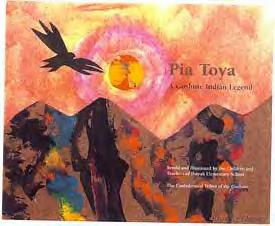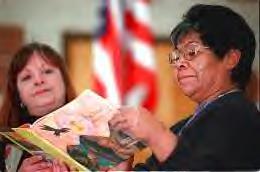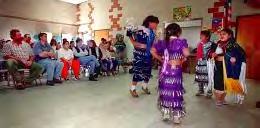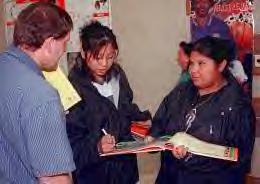|
Canku Ota |
|
(Many Paths) |
|
An Online Newsletter Celebrating Native America |
|
December 2, 2000 - Issue 24 |
|
|
|
Legend Comes to Life: |
|
'Pia Toya' book project helps develop tribal pride |
|
by Carma Wadley Desert News Senior Writer |
|
Photos by Scott G. Winterton, Desert News |
|
|
| A sense of place is an ancient and ingrained human need. Since time began, people have wanted to feel at home, have needed to know who and where they were. As they have attempted to make sense of their surroundings in myriad ways, a rich body of myth and legend has swirled through history. | |
|
|
So it is with the legend of Pia Toya, a story created ever-so-long ago by the Goshute
Indians to describe the formation of the Deep Creek Mountain Range that runs along Ibapah Valley in Utah's western
desert. Mother Hawk created the mountains in the time before people, the legend says. In a fit of anger because Coyote stole the breakfast she was bringing home to her nest, she flung down boulders and created the dust of a thousand storms and with her claws made cuts into the mountain that started creeks and springs flowing. Five years ago, the children of Ibapah Elementary school were looking for an art project and decided to illustrate the legend of Pia Toya. |
| The school had received some grant money, said Marilyn Linares, who taught at the school
at the time. She and Jim Thomas, the other teacher, used the project to bring in specialists in math, science,
the arts and culture. One of the specialists was artist Tamara Zollinger, who came once a month to help the children
do cutwork collages to illustrate the legend. By the end of the year, they had compiled a colorful version of the story. They made colored Xerox copies and had them bound so each student could have one, Thomas said. But the story of Pia Toya did not end there; and the next chapters have helped the students of Ibapah Elementary achieve not only a better sense of place but also a greater understanding of who they are. This month a handsome new version of "Pia Toya," a hardbound book containing the children's drawings, was delivered up by the University of Utah Press. And on Saturday, Nov. 4, copies of the book were presented to all the students involved — by now many of them in high school — at a community celebration in Ibapah. "It has just been a wonderful project," said Cyndy Talbot-Holz, executive director of Bonneville Resource Conservation and Development Council, a nonprofit corporation that works with the Goshute Tribe. "It has involved both the Goshute and the white community, who have come together to make exciting things happen." Although the story is a Goshute legend, it is a reminder of how the story of this area is everyone's story, she says. |
|
|
|
Ibapah may seem, at first glance, to be nothing more than an isolated community plunked
down in a harsh environment. Located about 55 miles south of Wendover, barely on the Utah side of the Nevada border,
it's about as far as you can go and still get somewhere — one of those "not quite the end of civilization
but close" places. With a population of about 150 in town and another 115 or so on the nearby Goshute Reservation, Ibapah ekes out a living based largely on cattle or sheep ranching, although these days more people do commute to Wendover for employment. |
| The elementary school has an enrollment of about 30, with about 75 percent of them Goshute. At one time, Ibapah Valley was the center of quite a lot. The Pony Express went through here, the telegraph followed, as did the Lincoln Highway. "It has a very rich history, but it's kind of been forgotten," Talbot-Holz said. The Goshutes have lived in the area for centuries, tribal historian Genevieve Fields says. And for them, too, life is changing. "The old traditions are going away; the language is going away. People ask me why I don't teach my kids the language; but who are they going to talk to?" The book project has been a great tool to help the younger generation develop tribal pride, she says. Milton Hooper, the Goshute representative on the Bonneville RC&D board of trustees, concurs. And he hopes it will help not only Goshute children but others as well. "Our Great Basin culture is often overlooked," he said. "People tend to focus more on the Great Plains or the Southern groups. Yet, we know things that can benefit all." Living in such a harsh environment meant his people had to put conservation principles into practice long before conservation became a watchword, says Hooper, who has been working with researchers from the University of Utah on an ethnobotany project to identify indigenous plants. "Utilization of resources; sustainability — we've known that for centuries." |
|
|
|
In addition to the legend, "Pia Toya" contains information about the Goshutes
and the area. "When I first saw it, I knew it was publishable," said Suzanne Somers of Somers-Jaramillo
& Co., the Goshute Tribe's environmental consultants. "I thought it would be a great tool for our outreach
education program." Somers sent the book to publishers all over the country. A lot were interested but felt it would be too expensive because of all the color, she says. "But without the color, it wouldn't be the book." In 1999, Bonneville RC&D decided to take it on as a project, and working with the University of Utah Press, and with additional support from the US Bank Corp., Tooele County, the Dumke Foundation and the Simmons Family Foundation, the book was finally published. |
|
"When I opened the book and saw our Library of Congress number, I just started
sobbing," Talbot-Holz said. Goshute Tribe |
|
|
|
|
|
| Canku Ota is a free Newsletter celebrating Native America, its traditions and accomplishments . We do not provide subscriber or visitor names to anyone. Some articles presented in Canku Ota may contain copyright material. We have received appropriate permissions for republishing any articles. Material appearing here is distributed without profit or monetary gain to those who have expressed an interest. This is in accordance with Title 17 U.S.C. section 107. |
|
Canku Ota is a copyright of Vicki Lockard and Paul Barry. |
|
The "Canku Ota - A Newsletter Celebrating Native America"
web site and its design is the Copyright © 1999 of Paul C. Barry. |



